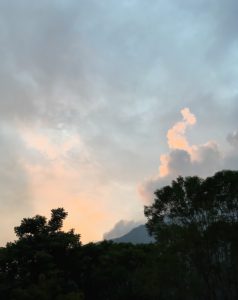Tonight is the full moon of the eighth Chinese lunar months in 2018—Mid-autumn Festival. It is one of the three major holidays of the lunar year. The other two being Chinese New Year (spring celebration) and Duanwu Festival (Dragon Boat Festival, beginning of summer). Traditionally, families get together on Mid-autumn Festival, celebrating the autumn harvest under the brightness of moonlight.
According to Chinese mythology, there are a few regular occupants on the moon: Chang’e (Chang-o) 嫦娥, the Moon Goddess; her companion Jade Rabbit 玉兔, eternally pounding immortal medicinal herbs; and Wu Gang 吳剛, chopping a never-falling laurel tree. There are different versions of stories associated with these mythological characters. Nevertheless, they all revolved around an immortal elixir. Was eternal loneliness the remuneration for the desire for immortality?
Growing up, Mid-Autumn Festival means mooncakes. They are the sweetest of Chinese sweets. The confluence of regional food cultures meant great variety in texture and taste: Taiwanese, Cantonese, Suzhou. . . They all have two things in common: round shape, symbolizing fulfillment of hope and family reunion, and dense fillings. The fillings are so thick that one can easily hide a message inside. According to folklore, at the end of the Yuan dynasty (the 14th century), revolutionaries used mooncakes to spread their messages overturning Mongolian rule. My favorite was Cantonese style cakes filled with lotus seed paste and salted egg yolks. Pineapple was my choice of fruity fillings. In recent years, influenced by Western desserts, there are long lists of new flavors.
Still, the most memorable thing was admiring the moon with my family. Usually mom would place a small table in the garden where we would have dinner under the moonlight. Then, we walked casually to Taiwan University, bringing with us cakes and fruits. We would sit by the large pond where we could look up to the moon and/or look down to its silvery reflection. Mom always asked if we could see the rabbit in the moon. I tried year after year. . . not that I actually believed there was a rabbit in the moon, but I wondered what in the moon caused our ancestors to make up such a story. We chatted quietly so not to disturb other families around us. As we enjoyed the sweets and fruits, the air cooled down and the grass dampened. Then, we knew it was time to go home.
During mom’s visits in Ohio, we tried celebrating Mid-Autumn Festival twice. The first time, we went to the bank of Lake Erie near downtown Cleveland. It was so cold and windy that we stayed no more than twenty minutes. The second time, we tried sitting on the patio in my own backyard. Even with blankets and candles, we still didn’t last very long.
In 2002, mom moved to New York with me. We invited mom’s old colleague Aunty Sophie and her husband to celebrate the holiday with us. After dinner, we went to the deck on the 32nd floor of my building. It seemed that we could almost reach the moon. Its silvery light glimmered on waves of the Hudson River. The small tea-flavored mooncakes were delicious. Mom, on a strange land, was very happy to be with old friends. It was the last time I celebrated Mid-Autumn Festival with mom.
A few times in late August, toward the end of my summer visits, Robert would get some mooncakes. We sat in the courtyard with mom, pretending there was a full moon. He remembered our beautiful time by the pond as clearly as I did.
In the last few decades, BBQ at parks and river banks became a popular Mid-Autumn Festival activity in Taiwan. Perhaps because it is so much in contrast to how my family used to celebrate the holiday, I never quite understand it. Maybe one of these years, I would be around to join the parties.
It rained in Taipei. Robert’s attempt to bring mom out to celebrate was cut short by the downpour.
Happy Mid-Autumn Festival: Wishing everyone fulfillment of wishes and harmonious family unity.

 Late August, traveling with my family. . .
Late August, traveling with my family. . . Decades later, staying at a bed and breakfast near Dajia River with all its amenities, I felt a deep sense of melancholy. There is a Chinese saying: 景物依舊, 人事全非 (The scenery is still as before, but people and conditions have all changed.) In this case, even the sceneries had changed a great deal. A 7.3 magnitude earthquake on September 21, 1999 not only destroyed multiple sections of the Cross-Island Highway but also reshaped central Taiwan geologically. Typhoon Mindulle ruined attempts to repair and reopen the roadway. Today, the section between Guguan and Lishan is indefinitely closed to regular traffic.
Decades later, staying at a bed and breakfast near Dajia River with all its amenities, I felt a deep sense of melancholy. There is a Chinese saying: 景物依舊, 人事全非 (The scenery is still as before, but people and conditions have all changed.) In this case, even the sceneries had changed a great deal. A 7.3 magnitude earthquake on September 21, 1999 not only destroyed multiple sections of the Cross-Island Highway but also reshaped central Taiwan geologically. Typhoon Mindulle ruined attempts to repair and reopen the roadway. Today, the section between Guguan and Lishan is indefinitely closed to regular traffic.